linux多线程以及互斥锁例子
linux下C语言多线程编程实例

互斥锁用来保证一段时间内只有一个线程在执行一段代码。
一 pthread_mutex_init
函数 pthread_mutex_init 用来生成一个互斥锁。NULL 参数表明使用默认属性。如果需要声明特 定属性的互斥锁,须调用函数 pthread_mutexattr_init。函数 pthread_mutexattr_setpshared 和函数 pthread_mutexattr_settype 用来设置互斥锁属性。前一个函数设置属性 pshared,它有 两个取值, PTHREAD_PROCESS_PRIVATE 和 PTHREAD_PROCESS_SHARED。前者用来不同进程中的线 程同步,后者用于同步本进程的不同线程。在上面的例子中,我们使用的是默认属性 PTHREAD_PROCESS_ PRIVATE。后者用来设置互斥锁类型,可选的类型有 PTHREAD_MUTEX_NORMAL、 PTHREAD_MUTEX_ERRORCHECK、 PTHREAD_MUTEX_RECURSIVE 和 PTHREAD _MUTEX_DEFAULT。它们分 别定义了不同的上所、解锁机制,一般情况下,选用最后一个默认属性。
void thread_create(void)
{
int temp;
memset(&thread, 0, sizeof(thread));
//comment1
/*创建线程*/
if((temp = pthread_create(&thread[0], NULL, thread1, NULL)) != 0)
下面是我们的代码: /*thread_example.c : c multiple thread programming in linux
linux线程间通信的几种方法

linux线程间通信的几种方法Linux是一种开源的操作系统,它支持多线程编程,因此线程间通信是非常重要的。
线程间通信是指在多个线程之间传递数据或信息的过程。
在Linux中,有多种方法可以实现线程间通信,本文将介绍其中的几种方法。
1. 信号量信号量是一种用于线程间同步和互斥的机制。
它可以用来控制对共享资源的访问。
在Linux中,信号量是由sem_t类型的变量表示的。
它有三个主要的操作:初始化、P操作和V操作。
初始化操作用于初始化信号量的值。
P操作用于获取信号量,如果信号量的值为0,则线程会被阻塞,直到信号量的值大于0。
V操作用于释放信号量,将信号量的值加1。
下面是一个使用信号量实现线程间通信的例子:```#include <stdio.h>#include <pthread.h>#include <semaphore.h>sem_t sem;void *thread1(void *arg){sem_wait(&sem);printf("Thread 1\n");sem_post(&sem);pthread_exit(NULL);}void *thread2(void *arg){sem_wait(&sem);printf("Thread 2\n");sem_post(&sem);pthread_exit(NULL);}int main(){pthread_t t1, t2;sem_init(&sem, 0, 1);pthread_create(&t1, NULL, thread1, NULL); pthread_create(&t2, NULL, thread2, NULL); pthread_join(t1, NULL);pthread_join(t2, NULL);sem_destroy(&sem);return 0;}```在这个例子中,我们创建了两个线程,它们都需要获取信号量才能执行。
跟我学Linux编程-12-多线程编程-同步
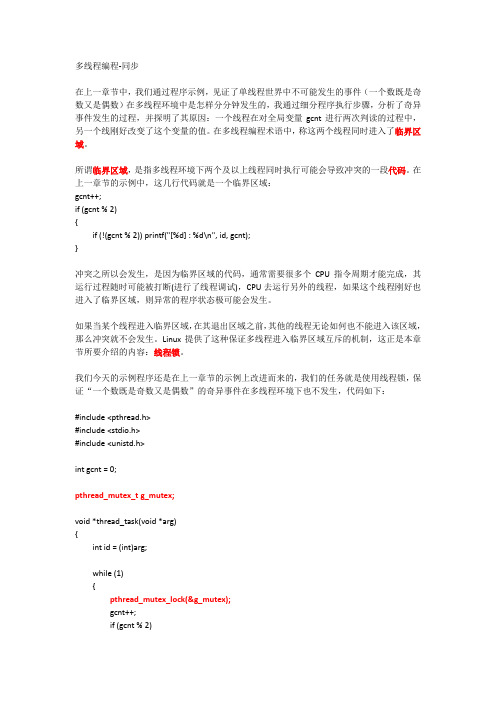
多线程编程-同步在上一章节中,我们通过程序示例,见证了单线程世界中不可能发生的事件(一个数既是奇数又是偶数)在多线程环境中是怎样分分钟发生的,我通过细分程序执行步骤,分析了奇异事件发生的过程,并探明了其原因:一个线程在对全局变量gcnt进行两次判读的过程中,另一个线刚好改变了这个变量的值。
在多线程编程术语中,称这两个线程同时进入了临界区域。
所谓临界区域,是指多线程环境下两个及以上线程同时执行可能会导致冲突的一段代码。
在上一章节的示例中,这几行代码就是一个临界区域:gcnt++;if (gcnt % 2){if (!(gcnt % 2)) printf("[%d] : %d\n", id, gcnt);}冲突之所以会发生,是因为临界区域的代码,通常需要很多个CPU指令周期才能完成,其运行过程随时可能被打断(进行了线程调试),CPU去运行另外的线程,如果这个线程刚好也进入了临界区域,则异常的程序状态极可能会发生。
如果当某个线程进入临界区域,在其退出区域之前,其他的线程无论如何也不能进入该区域,那么冲突就不会发生。
Linux提供了这种保证多线程进入临界区域互斥的机制,这正是本章节所要介绍的内容:线程锁。
我们今天的示例程序还是在上一章节的示例上改进而来的,我们的任务就是使用线程锁,保证“一个数既是奇数又是偶数”的奇异事件在多线程环境下也不发生,代码如下:#include <pthread.h>#include <stdio.h>#include <unistd.h>int gcnt = 0;pthread_mutex_t g_mutex;void *thread_task(void *arg){int id = (int)arg;while (1){pthread_mutex_lock(&g_mutex);gcnt++;if (gcnt % 2)if (!(gcnt % 2)) printf("[%d] : %d\n", id, gcnt);}pthread_mutex_unlock(&g_mutex);usleep(1);}return NULL;}int main(int argc, char *argv[]){pthread_t thr;pthread_mutex_init(&g_mutex, NULL);pthread_create(&thr, NULL, thread_task, (void *)1);pthread_create(&thr, NULL, thread_task, (void *)2);thread_task((void *)0);return 0;}今天的程序相对于上章的代码,改动非常小,只添加了四行,已使用红色加粗标注。
linux pthread 用法

linux pthread 用法Linux pthread(POSIX线程)是一种多线程库,它提供了在Linux系统上创建和管理线程的API。
使用pthread库,可以编写多线程程序,实现并发执行和资源共享。
下面是一些常用的pthread函数和用法:1.pthread_create():用于创建一个新的线程。
它接受一个指向线程属性的指针,一个指向线程函数的指针,以及传递给线程函数的参数。
函数原型为:intpthread_create(pthread_t *thread, const pthread_attr_t *attr, void*(*start_routine) (void *), void *arg);2.pthread_join():用于等待一个线程的结束。
它接受一个指向线程标识符的指针,以及一个指向用于存储线程返回值的指针的指针。
函数原型为:intpthread_join(pthread_t thread, void **retval);3.pthread_self():用于获取当前线程的标识符。
函数原型为:pthread_tpthread_self(void);4.pthread_detach():用于将一个线程从系统中分离出去。
这通常用于在后台运行的任务,不需要手动等待它们完成。
函数原型为:int pthread_detach(pthread_t thread);5.pthread_equal():用于比较两个线程标识符是否相等。
函数原型为:intpthread_equal(pthread_t thread1, pthread_t thread2);6.pthread_mutex_init():用于初始化一个互斥锁。
函数原型为:intpthread_mutex_init(pthread_mutex_t *mutex, const pthread_mutexattr_t *attr); 7.pthread_mutex_lock():用于获取一个互斥锁。
linux下的CC++多进程多线程编程实例详解
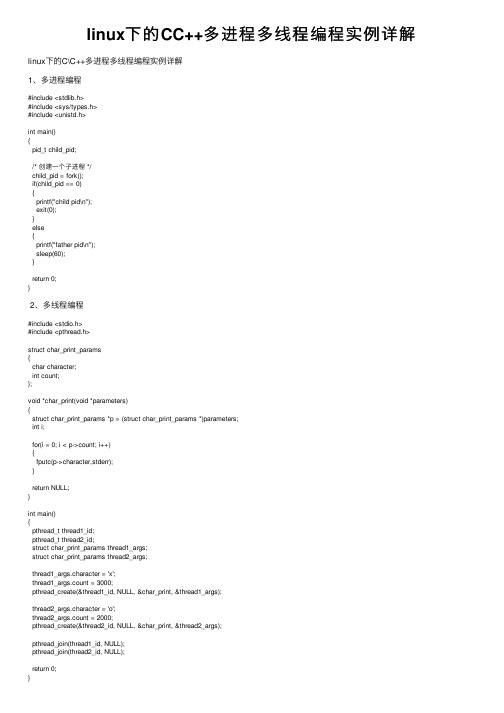
linux下的CC++多进程多线程编程实例详解linux下的C\C++多进程多线程编程实例详解1、多进程编程#include <stdlib.h>#include <sys/types.h>#include <unistd.h>int main(){pid_t child_pid;/* 创建⼀个⼦进程 */child_pid = fork();if(child_pid == 0){printf("child pid\n");exit(0);}else{printf("father pid\n");sleep(60);}return 0;}2、多线程编程#include <stdio.h>#include <pthread.h>struct char_print_params{char character;int count;};void *char_print(void *parameters){struct char_print_params *p = (struct char_print_params *)parameters;int i;for(i = 0; i < p->count; i++){fputc(p->character,stderr);}return NULL;}int main(){pthread_t thread1_id;pthread_t thread2_id;struct char_print_params thread1_args;struct char_print_params thread2_args;thread1_args.character = 'x';thread1_args.count = 3000;pthread_create(&thread1_id, NULL, &char_print, &thread1_args);thread2_args.character = 'o';thread2_args.count = 2000;pthread_create(&thread2_id, NULL, &char_print, &thread2_args);pthread_join(thread1_id, NULL);pthread_join(thread2_id, NULL);return 0;}3、线程同步与互斥1)、互斥pthread_mutex_t mutex;pthread_mutex_init(&mutex, NULL);/*也可以⽤下⾯的⽅式初始化*/pthread_mutex_t mutex = PTHREAD_MUTEX_INITIALIZER; pthread_mutex_lock(&mutex);/* 互斥 */thread_flag = value;pthread_mutex_unlock(&mutex);2)、条件变量int thread_flag = 0;pthread_mutex_t mutex;pthread_cond_t thread_flag_cv;\void init_flag(){pthread_mutex_init(&mutex, NULL);pthread_cond_init(&thread_flag_cv, NULL);thread_flag = 0;}void *thread_function(void *thread_flag){while(1){pthread_mutex_lock(&mutex);while(thread_flag != 0 ){pthread_cond_wait(&thread_flag_cv, &mutex);}pthread_mutex_unlock(&mutex);do_work();}return NULL;}void set_thread_flag(int flag_value){pthread_mutex_lock(&mutex);thread_flag = flag_value;pthread_cond_signal(&thread_flag_cv);pthread_mutex_unlock(&mutex);}感谢阅读,希望能帮助到⼤家,谢谢⼤家对本站的⽀持!。
linux pthread_mutex的原理

linux pthread_mutex的原理摘要:1.引言2.pthread_mutex 的作用3.pthread_mutex 的工作原理4.pthread_mutex 的使用方法5.总结正文:Linux 中的pthread_mutex 是一种互斥锁,主要用于多线程程序中,以防止多个线程同时访问共享资源造成数据混乱。
pthread_mutex 提供了一种机制,使得在同一时刻只有一个线程可以访问共享资源。
pthread_mutex 的工作原理是通过对共享资源进行加锁和解锁来实现的。
当一个线程需要访问共享资源时,首先尝试对pthread_mutex 进行加锁,如果锁已经被其他线程占用,那么当前线程会被阻塞,等待锁被释放。
当锁被释放后,该线程会被唤醒,继续尝试加锁,直到成功为止。
当线程完成对共享资源的访问后,需要释放pthread_mutex,以便其他线程可以访问共享资源。
在Linux 中,pthread_mutex 有多种操作方法。
首先,需要使用pthread_mutex_init 函数初始化一个pthread_mutex,该函数需要传入两个参数,一个是互斥锁的名称,另一个是互斥锁的初始化模式。
其次,使用pthread_mutex_lock 函数尝试对pthread_mutex 加锁,如果加锁失败,函数会返回一个错误码。
然后,使用pthread_mutex_unlock 函数释放pthread_mutex,使得其他线程可以访问共享资源。
最后,使用pthread_mutex_destroy 函数销毁一个pthread_mutex,该函数会等待所有线程释放该互斥锁后才真正销毁。
Linux系统线程创建及同步互斥方法简要说明(供查考)
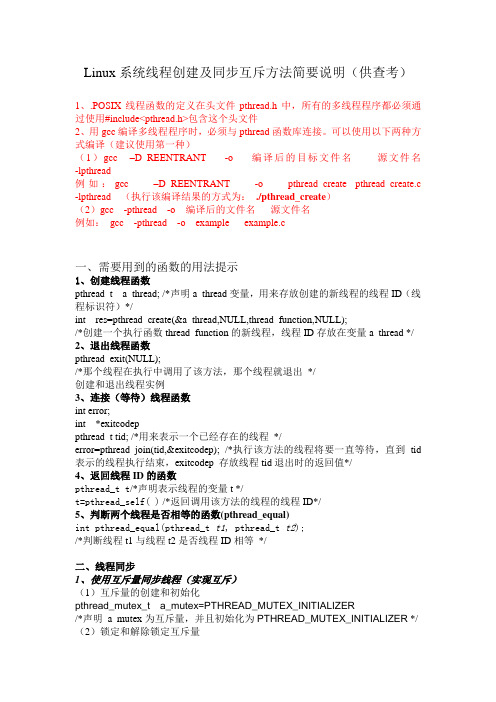
Linux系统线程创建及同步互斥方法简要说明(供查考)1、.POSIX线程函数的定义在头文件pthread.h中,所有的多线程程序都必须通过使用#include<pthread.h>包含这个头文件2、用gcc编译多线程程序时,必须与pthread函数库连接。
可以使用以下两种方式编译(建议使用第一种)(1)gcc –D_REENTRANT -o 编译后的目标文件名源文件名-lpthread例如:gcc –D_REENTRANT -o pthread_create pthread_create.c -lpthread (执行该编译结果的方式为:./pthread_create)(2)gcc -pthread -o 编译后的文件名源文件名例如:gcc -pthread -o example example.c一、需要用到的函数的用法提示1、创建线程函数pthread_t a_thread; /*声明a_thread变量,用来存放创建的新线程的线程ID(线程标识符)*/int res=pthread_create(&a_thread,NULL,thread_function,NULL);/*创建一个执行函数thread_function的新线程,线程ID存放在变量a_thread */ 2、退出线程函数pthread_exit(NULL);/*那个线程在执行中调用了该方法,那个线程就退出*/创建和退出线程实例3、连接(等待)线程函数int error;int *exitcodeppthread_t tid; /*用来表示一个已经存在的线程*/error=pthread_join(tid,&exitcodep); /*执行该方法的线程将要一直等待,直到tid 表示的线程执行结束,exitcodep 存放线程tid退出时的返回值*/4、返回线程ID的函数pthread_t t/*声明表示线程的变量t */t=pthread_self( ) /*返回调用该方法的线程的线程ID*/5、判断两个线程是否相等的函数(pthread_equal)int pthread_equal(pthread_t t1, pthread_t t2);/*判断线程t1与线程t2是否线程ID相等*/二、线程同步1、使用互斥量同步线程(实现互斥)(1)互斥量的创建和初始化pthread_mutex_t a_mutex=PTHREAD_MUTEX_INITIALIZER/*声明a_mutex为互斥量,并且初始化为PTHREAD_MUTEX_INITIALIZER */ (2)锁定和解除锁定互斥量pthread_mutex_t a_mutex=PTHREAD_MUTEX_INITIALIZER/*声明互斥量a_mutex*/int rc=pthread_mutex_lock(&a_mutex) /*锁定互斥量a_mutex*/ ………………………………/*锁定后的操作*/int rd= pthread_mutex_unlock(&a_mutex) /*解除对互斥量a_mutex的锁定*/例子:利用互斥量来保护一个临界区pthread_mutex_t a_mutex=PTHREAD_MUTEX_INITIALIZER;pthread_mutex_lock(&a_mutex) /*锁定互斥量a_mutex*//*临界区资源*/pthread_mutex_unlock(&a_mutex) /*解除互斥量a_mutex的锁定*/(3)销毁互斥量Int rc=pthread_mutex_destory(&a_mutex) /*销毁互斥量a_mutex*/2、用条件变量同步线程(实现真正的同步)条件变量是利用线程间共享的全局变量进行同步的一种机制,主要包括两个动作:一个线程等待"条件变量的条件成立"而挂起;另一个线程使"条件成立"(给出条件成立信号)。
Linux多线程编程问题
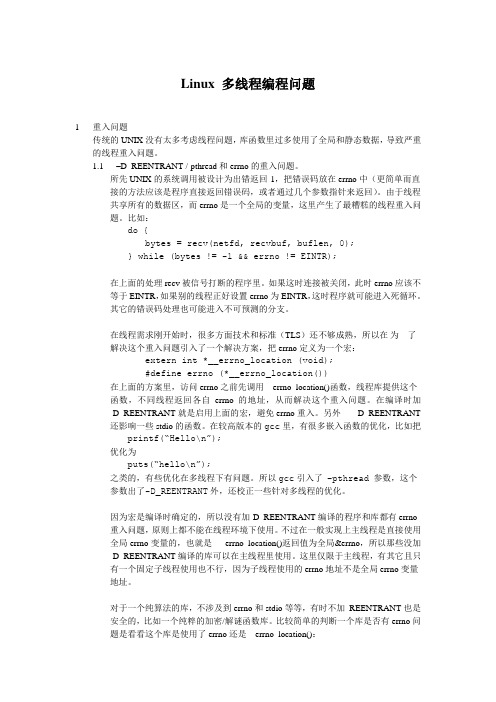
Linux 多线程编程问题1重入问题传统的UNIX没有太多考虑线程问题,库函数里过多使用了全局和静态数据,导致严重的线程重入问题。
1.1–D_REENTRANT /-pthread和errno的重入问题。
所先UNIX的系统调用被设计为出错返回-1,把错误码放在errno中(更简单而直接的方法应该是程序直接返回错误码,或者通过几个参数指针来返回)。
由于线程共享所有的数据区,而errno是一个全局的变量,这里产生了最糟糕的线程重入问题。
比如:do {bytes = recv(netfd, recvbuf, buflen, 0);} while (bytes != -1 && errno != EINTR);在上面的处理recv被信号打断的程序里。
如果这时连接被关闭,此时errno应该不等于EINTR,如果别的线程正好设置errno为EINTR,这时程序就可能进入死循环。
其它的错误码处理也可能进入不可预测的分支。
在线程需求刚开始时,很多方面技术和标准(TLS)还不够成熟,所以在为了解决这个重入问题引入了一个解决方案,把errno定义为一个宏:extern int *__errno_location (void);#define errno (*__errno_location())在上面的方案里,访问errno之前先调用__errno_location()函数,线程库提供这个函数,不同线程返回各自errno的地址,从而解决这个重入问题。
在编译时加-D_REENTRANT就是启用上面的宏,避免errno重入。
另外-D_REENTRANT还影响一些stdio的函数。
在较高版本的gcc里,有很多嵌入函数的优化,比如把printf(“Hello\n”);优化为puts(“hello\n”);之类的,有些优化在多线程下有问题。
所以gcc引入了–pthread 参数,这个参数出了-D_REENTRANT外,还校正一些针对多线程的优化。
linux中的同步机制
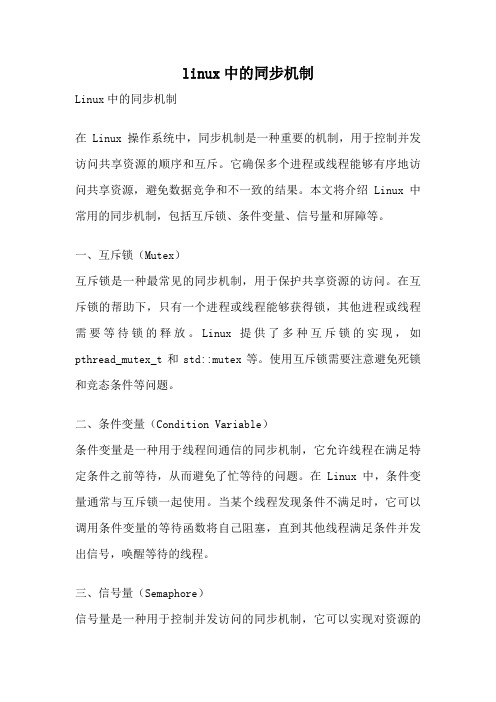
linux中的同步机制Linux中的同步机制在Linux操作系统中,同步机制是一种重要的机制,用于控制并发访问共享资源的顺序和互斥。
它确保多个进程或线程能够有序地访问共享资源,避免数据竞争和不一致的结果。
本文将介绍Linux中常用的同步机制,包括互斥锁、条件变量、信号量和屏障等。
一、互斥锁(Mutex)互斥锁是一种最常见的同步机制,用于保护共享资源的访问。
在互斥锁的帮助下,只有一个进程或线程能够获得锁,其他进程或线程需要等待锁的释放。
Linux提供了多种互斥锁的实现,如pthread_mutex_t和std::mutex等。
使用互斥锁需要注意避免死锁和竞态条件等问题。
二、条件变量(Condition Variable)条件变量是一种用于线程间通信的同步机制,它允许线程在满足特定条件之前等待,从而避免了忙等待的问题。
在Linux中,条件变量通常与互斥锁一起使用。
当某个线程发现条件不满足时,它可以调用条件变量的等待函数将自己阻塞,直到其他线程满足条件并发出信号,唤醒等待的线程。
三、信号量(Semaphore)信号量是一种用于控制并发访问的同步机制,它可以实现对资源的计数和管理。
Linux提供了两种类型的信号量:二进制信号量和计数信号量。
二进制信号量只有两种状态(0和1),用于互斥访问共享资源;计数信号量可以有多个状态,用于限制并发访问的数量。
通过使用信号量,可以实现进程或线程之间的同步和互斥。
四、屏障(Barrier)屏障是一种用于线程同步的机制,它在多个线程到达指定点之前将它们阻塞,直到所有线程都到达后才继续执行。
屏障可以用于并行计算中的阶段同步,确保每个阶段的计算完成后再进行下一阶段的计算。
在Linux中,可以使用pthread_barrier_t来创建和操作屏障。
五、读写锁(ReadWrite Lock)读写锁是一种特殊的锁机制,用于在读操作和写操作之间提供更好的并发性。
读写锁允许多个线程同时读取共享资源,但只允许一个线程进行写操作。
在linux下实现读者写者问题源代码

在linux下实现读者写者问题源代码读者写者问题是计算机科学中的一个经典同步问题,用于描述多个读者和写者对共享资源的访问。
在这个问题中,多个读者可以同时读取共享资源,但是写者在写入共享资源时必须独占访问。
在Linux下,我们可以使用线程和互斥锁来实现读者写者问题。
下面是一个简单的源代码示例:```c#include <stdio.h>#include <stdlib.h>#include <pthread.h>#define READERS_COUNT 5#define WRITERS_COUNT 2pthread_mutex_t mutex;pthread_cond_t cond_reader, cond_writer;int readers = 0;int writers = 0;void *reader(void *arg) {int id = *(int *)arg;while (1) {pthread_mutex_lock(&mutex);while (writers > 0) {pthread_cond_wait(&cond_reader, &mutex); }readers++;pthread_mutex_unlock(&mutex);// 读取共享资源printf("Reader %d is reading\n", id);pthread_mutex_lock(&mutex);readers--;if (readers == 0) {pthread_cond_signal(&cond_writer);}pthread_mutex_unlock(&mutex);}pthread_exit(NULL);}void *writer(void *arg) {int id = *(int *)arg;while (1) {pthread_mutex_lock(&mutex);while (readers > 0 || writers > 0) {pthread_cond_wait(&cond_writer, &mutex); }writers++;pthread_mutex_unlock(&mutex);// 写入共享资源printf("Writer %d is writing\n", id);pthread_mutex_lock(&mutex);writers--;pthread_cond_signal(&cond_writer);pthread_cond_broadcast(&cond_reader);pthread_mutex_unlock(&mutex);}pthread_exit(NULL);}int main() {pthread_t readers[READERS_COUNT];pthread_t writers[WRITERS_COUNT];int reader_ids[READERS_COUNT];int writer_ids[WRITERS_COUNT];pthread_mutex_init(&mutex, NULL);pthread_cond_init(&cond_reader, NULL);pthread_cond_init(&cond_writer, NULL);// 创建读者线程for (int i = 0; i < READERS_COUNT; i++) {reader_ids[i] = i + 1;pthread_create(&readers[i], NULL, reader, &reader_ids[i]); }// 创建写者线程for (int i = 0; i < WRITERS_COUNT; i++) {writer_ids[i] = i + 1;pthread_create(&writers[i], NULL, writer, &writer_ids[i]); }// 等待线程结束for (int i = 0; i < READERS_COUNT; i++) {pthread_join(readers[i], NULL);}for (int i = 0; i < WRITERS_COUNT; i++) {pthread_join(writers[i], NULL);}pthread_mutex_destroy(&mutex);pthread_cond_destroy(&cond_reader);pthread_cond_destroy(&cond_writer);return 0;}```在这个源代码中,我们使用了互斥锁(`pthread_mutex_t`)和条件变量(`pthread_cond_t`)来实现读者写者问题的同步。
linux rcu锁原理
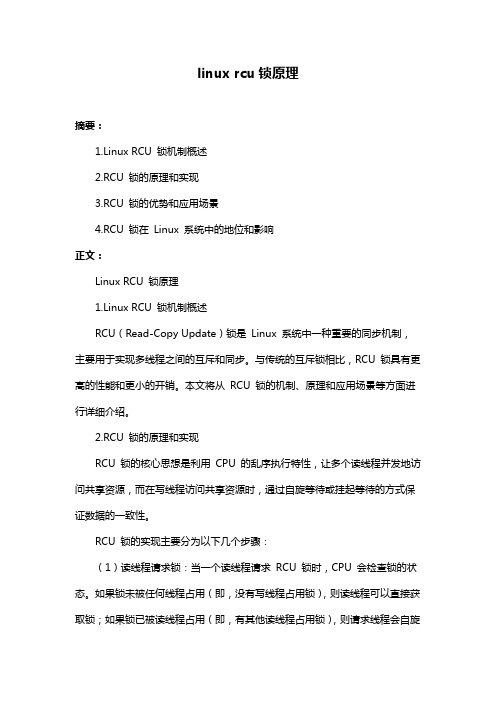
linux rcu锁原理摘要:1.Linux RCU 锁机制概述2.RCU 锁的原理和实现3.RCU 锁的优势和应用场景4.RCU 锁在Linux 系统中的地位和影响正文:Linux RCU 锁原理1.Linux RCU 锁机制概述RCU(Read-Copy Update)锁是Linux 系统中一种重要的同步机制,主要用于实现多线程之间的互斥和同步。
与传统的互斥锁相比,RCU 锁具有更高的性能和更小的开销。
本文将从RCU 锁的机制、原理和应用场景等方面进行详细介绍。
2.RCU 锁的原理和实现RCU 锁的核心思想是利用CPU 的乱序执行特性,让多个读线程并发地访问共享资源,而在写线程访问共享资源时,通过自旋等待或挂起等待的方式保证数据的一致性。
RCU 锁的实现主要分为以下几个步骤:(1)读线程请求锁:当一个读线程请求RCU 锁时,CPU 会检查锁的状态。
如果锁未被任何线程占用(即,没有写线程占用锁),则读线程可以直接获取锁;如果锁已被读线程占用(即,有其他读线程占用锁),则请求线程会自旋等待;如果锁已被写线程占用(即,有写线程占用锁),则请求线程会挂起等待。
(2)读线程释放锁:当一个读线程完成对共享资源的访问并释放RCU 锁时,CPU 会检查锁的状态。
如果锁未被任何线程占用(即,没有写线程占用锁),则释放锁;如果锁已被其他读线程占用(即,有其他读线程占用锁),则将锁的状态设置为可读状态;如果锁已被写线程占用(即,有写线程占用锁),则不会释放锁。
(3)写线程请求锁:当一个写线程请求RCU 锁时,CPU 会检查锁的状态。
如果锁未被任何线程占用(即,没有读线程或写线程占用锁),则写线程可以直接获取锁;如果锁已被读线程占用(即,有其他读线程占用锁),则写线程会挂起等待;如果锁已被写线程占用(即,有其他写线程占用锁),则请求线程会自旋等待。
(4)写线程释放锁:当一个写线程完成对共享资源的修改并释放RCU 锁时,CPU 会检查锁的状态。
linux线程间同步和互斥的方法

linux线程间同步和互斥的方法随着计算机技术的飞速发展,多线程应用已经变得越来越普遍。
在Linux操作系统中,多线程是一种强大的工具,它允许程序同时执行多个任务,从而提高系统的并发性和效率。
然而,多线程应用也带来了一些挑战,如线程间的同步和互斥问题。
本文将介绍Linux线程间同步和互斥的方法。
一、互斥(Mutex)互斥是最基本的同步机制之一,用于保护共享资源,防止多个线程同时访问同一资源而造成数据混乱。
在Linux中,可以使用pthread_mutex_t类型来创建互斥锁。
使用pthread_mutex_lock()函数来锁定互斥锁,确保同一时刻只有一个线程可以访问被保护的资源;使用pthread_mutex_unlock()函数来解锁互斥锁,允许其他线程访问该资源。
二、条件变量(ConditionVariable)条件变量是一种更复杂的同步机制,它允许一个或多个线程在满足某个条件时被唤醒。
在Linux中,可以使用pthread_cond_t类型来创建条件变量。
线程可以通过pthread_cond_wait()函数进入等待状态,直到条件满足时被唤醒。
使用pthread_cond_signal()或pthread_cond_broadcast()函数来通知其他等待的线程。
三、读写锁(Read-WriteLock)读写锁是一种更高效的同步机制,它允许多个读线程同时访问共享资源,但在写操作时只允许一个写线程访问。
在Linux中,可以使用pthread_rwlock_t类型来创建读写锁。
读线程可以同时获取读锁,而写线程必须获取写锁。
当写线程释放写锁时,读线程可以再次获取读锁。
这种机制可以提高并发性能,降低资源争用的开销。
四、信号量(Semaphore)信号量是一种用于控制并发访问的计数器。
它通常用于计数有限的资源数量,如文件描述符或磁盘空间。
在Linux中,可以使用sem_t 类型来创建信号量。
使用sem_wait()函数来减少信号量的值,表示消耗了一个资源;使用sem_post()函数来增加信号量的值,表示释放了一个资源。
linux 互斥锁 信号量 自旋锁 实现原理
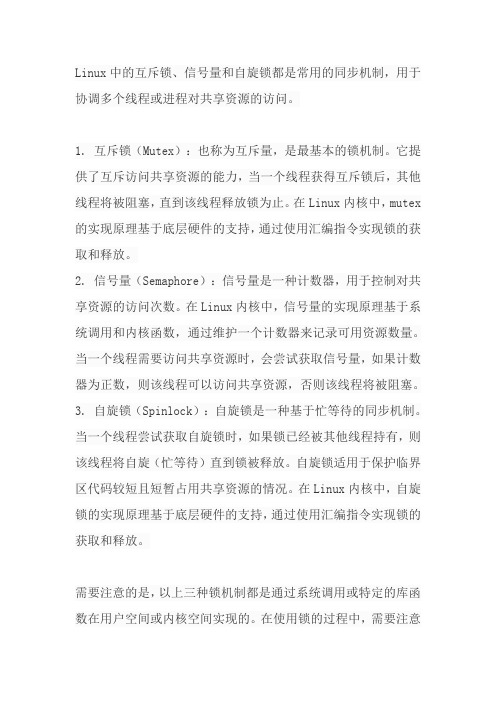
Linux中的互斥锁、信号量和自旋锁都是常用的同步机制,用于协调多个线程或进程对共享资源的访问。
1. 互斥锁(Mutex):也称为互斥量,是最基本的锁机制。
它提供了互斥访问共享资源的能力,当一个线程获得互斥锁后,其他线程将被阻塞,直到该线程释放锁为止。
在Linux内核中,mutex 的实现原理基于底层硬件的支持,通过使用汇编指令实现锁的获取和释放。
2. 信号量(Semaphore):信号量是一种计数器,用于控制对共享资源的访问次数。
在Linux内核中,信号量的实现原理基于系统调用和内核函数,通过维护一个计数器来记录可用资源数量。
当一个线程需要访问共享资源时,会尝试获取信号量,如果计数器为正数,则该线程可以访问共享资源,否则该线程将被阻塞。
3. 自旋锁(Spinlock):自旋锁是一种基于忙等待的同步机制。
当一个线程尝试获取自旋锁时,如果锁已经被其他线程持有,则该线程将自旋(忙等待)直到锁被释放。
自旋锁适用于保护临界区代码较短且短暂占用共享资源的情况。
在Linux内核中,自旋锁的实现原理基于底层硬件的支持,通过使用汇编指令实现锁的获取和释放。
需要注意的是,以上三种锁机制都是通过系统调用或特定的库函数在用户空间或内核空间实现的。
在使用锁的过程中,需要注意
避免死锁(Deadlock)和饥饿(Starvation)等并发编程中常见的问题。
linux c entercriticalsection -回复

linux c entercriticalsection -回复关于在Linux环境下进入和操作临界区(Critical Section)的相关讨论临界区是指在多线程编程中一段对共享资源进行访问和操作的代码区域。
由于同时访问共享资源可能导致数据不一致或其他问题,因此需要保证在任意时刻只有一个线程可以进入临界区。
在Linux环境下,我们可以使用各种方法和技术来实现对临界区的进入和保护。
在Linux环境中,最常用的方法之一是使用互斥锁(Mutex)。
互斥锁是一种同步原语,用于保护共享资源的访问。
它允许线程进入临界区,并阻塞其他线程直到该线程释放锁。
互斥锁可以通过pthread库实现。
在进入临界区之前,线程必须先获取互斥锁,在退出临界区之前,必须释放互斥锁。
以下是一个简单的示例代码:c#include <stdio.h>#include <pthread.h>pthread_mutex_t mutex;void* thread_func(void* arg) {线程尝试获取互斥锁pthread_mutex_lock(&mutex);临界区代码printf("线程进入临界区\n");访问共享资源释放互斥锁pthread_mutex_unlock(&mutex);return NULL;}int main() {pthread_t thread_id;pthread_mutex_init(&mutex, NULL);创建多个线程来访问临界区for (int i = 0; i < 5; i++) {pthread_create(&thread_id, NULL, thread_func, NULL);}pthread_mutex_destroy(&mutex);pthread_exit(NULL);return 0;}在上面的代码中,我们首先定义了一个全局的互斥锁`mutex`。
linux pthread_mutex的原理 -回复

linux pthread_mutex的原理-回复Linux中的pthread_mutex是一种用于多线程编程的同步原语,它提供了互斥锁的功能,用于保护共享资源的访问。
在本文中,我们将深入探讨pthread_mutex的原理,并逐步回答有关它的关键问题。
一、什么是pthread_mutex?pthread_mutex是POSIX标准中定义的一种多线程同步机制,pthread_mutex用于协调多个线程对共享资源的访问。
它提供了两种主要的操作:锁定(lock)和解锁(unlock)。
线程在访问共享资源之前必须先锁定互斥锁,然后在完成访问后再解锁互斥锁,以确保只有一个线程可以同时访问共享资源。
二、pthread_mutex的类型pthread_mutex有几种不同的类型,包括普通锁(PTHREAD_MUTEX_NORMAL)、错误检查锁(PTHREAD_MUTEX_ERRORCHECK)、递归锁(PTHREAD_MUTEX_RECURSIVE)以及默认类型(PTHREAD_MUTEX_DEFAULT)等。
每种类型都有其特定的用途和行为。
1. 普通锁(PTHREAD_MUTEX_NORMAL):该类型的锁没有死锁检测机制,如果一个线程重复锁定同一个互斥锁,则会导致死锁。
因此,开发者需要自行确保在使用该类型锁时避免死锁的情况发生。
2. 错误检查锁(PTHREAD_MUTEX_ERRORCHECK):该类型的锁提供了死锁检测功能。
当一个线程试图再次锁定已经被其自身所锁定的互斥锁时,将返回一个错误码,并不会导致死锁。
这种类型可以帮助开发者在调试过程中尽早发现潜在的死锁问题。
3. 递归锁(PTHREAD_MUTEX_RECURSIVE):该类型的锁可以被同一个线程多次锁定,而不会导致死锁。
每次锁定时都会增加一个计数器,只有当计数器归零时才会解锁。
这种类型的锁适用于那些需要在递归调用中保护共享资源的情况。
4. 默认类型(PTHREAD_MUTEX_DEFAULT):该类型会根据具体的实现选择合适的类型,可能是锁定或递归锁。
Linux互斥锁、条件变量和信号量

Linux--Linux互斥锁、条件变量和信号量进行多线程编程,最应该注意的就是那些共享的数据,因为无法知道哪个线程会在哪个时候对它进行操作,也无法得知哪个线程会先运行,哪个线程会后运行。
所以,要对这些资源进行合理的分配和正确的使用。
在Linux下,提供了互斥锁、条件变量和信号量来对共享资源进行保护。
一、互斥锁互斥锁,是一种信号量,常用来防止两个进程或线程在同一时刻访问相同的共享资源。
需要的头文件:pthread.h互斥锁标识符:pthread_mutex_t(1)互斥锁初始化:函数原型:int pthread_mutex_init (pthread_mutex_t* mutex,const pthread_mutexattr_t* mutexattr);函数传入值:mutex:互斥锁。
mutexattr:PTHREAD_MUTEX_INITIALIZER 创建快速互斥锁。
PTHREAD_RECURSIVE_MUTEX_INITIALIZER_NP 创建递归互斥锁。
PTHREAD_ERRORCHECK_MUTEX_INITIALIZER_NP 创建检错互斥锁。
函数返回值:成功:0;出错:-1(2)互斥操作函数int pthread_mutex_lock(pthread_mutex_t* mutex); //上锁int pthread_mutex_trylock (pthread_mutex_t* mutex); //只有在互斥被锁住的情况下才阻塞int pthread_mutex_unlock (pthread_mutex_t* mutex); //解锁int pthread_mutex_destroy (pthread_mutex_t* mutex); //清除互斥锁函数传入值:mutex:互斥锁。
函数返回值:成功:0;出错:-1使用形式:pthread_mutex_t mutex;pthread_mutex_init (&mutex, NULL); /*定义*/...pthread_mutex_lock(&mutex); /*获取互斥锁*/... /*临界资源*/pthread_mutex_unlock(&mutex); /*释放互斥锁*/备注:互斥锁MUTEX的使用注意lock和unlock的配对使用,否则容易出现死锁发生。
多线程保证线程安全的方法

多线程保证线程安全的方法多线程编程中,线程安全是一个重要的问题。
如果多个线程同时访问共享数据,可能会导致数据的不一致性或者错误的结果。
为了保证线程的安全,需要采取一系列的保护措施来避免竞态条件(race condition)、死锁(deadlock)等问题的发生。
本文将介绍一些常见的多线程保证线程安全的方法。
1. 互斥锁(Mutex):互斥锁是最常见的保证线程安全的方法之一、当线程要访问共享数据时,先锁定互斥锁,其他线程要访问同一份数据时需要等待互斥锁被释放。
互斥锁一次只能被一个线程占有,从而避免了多个线程同时访问共享数据的问题。
2. 读写锁(ReadWrite Lock):在一些场景下,多个线程只读取共享数据而不修改它们。
这种情况下,可以使用读写锁来提高性能。
读写锁允许多个线程同时读取共享数据,但在有写操作时,会阻塞其他线程的读和写操作,从而保证数据的一致性。
3. 原子操作(Atomic Operations):原子操作是指能够在单个步骤中完成的操作,不会被其他线程中断。
在多线程编程中,可以使用原子操作保证共享数据的连续性。
例如,Java提供了原子类(如AtomicInteger、AtomicLong等)来保证整数操作的原子性。
4. 同步代码块(Synchronized Block):通过使用synchronized关键字修饰一个代码块,可以将其变成互斥区域,即在同一时间只允许一个线程执行该代码块。
线程进入synchronized代码块时会自动获得锁,执行完代码块后会释放锁,其他线程才能继续执行。
这样可以保证在同一时间只有一个线程执行临界区(即使用共享数据的代码段)。
5. 同步方法(Synchronized Method):可以使用synchronized关键字修饰方法,使其成为同步方法。
同步方法与同步代码块类似,只是作用范围更大,锁定的是整个方法。
多个线程在执行同步方法时,会对该对象的锁进行争夺,并且只有一个线程能够执行同步方法。
linux lock用法

linux lock用法Linux中的lock用法在Linux系统中,lock(锁)是一种用来同步线程或进程间访问共享资源的机制。
通过使用锁,可以确保同一时间只有一个线程或进程能够访问某个共享资源,从而避免了数据不一致的问题。
在Linux中,lock的用法主要通过使用互斥锁(mutex lock)或读写锁(read-write lock)来实现。
1. 互斥锁(mutex lock):互斥锁是最常用的锁机制之一,它确保在任意时间点只有一个线程能够访问共享资源。
当一个线程获得了互斥锁,其他线程就必须等待该线程释放锁后才能获得锁。
互斥锁的使用可以通过以下步骤进行:- 初始化互斥锁。
- 在需要访问共享资源的代码块前,使用lock()函数来锁住互斥锁。
- 当共享资源访问完成后,使用unlock()函数来释放互斥锁。
2. 读写锁(read-write lock):读写锁允许多个读操作同时进行,但只允许一个写操作进行。
这种锁机制在对共享资源进行读取操作的频率远高于写操作的情况下,可以提高系统的并发性能。
读写锁的使用可以通过以下步骤进行:- 初始化读写锁。
- 在需要读取共享资源的代码块前,使用read_lock()函数来获取读锁。
- 在需要修改共享资源的代码块前,使用write_lock()函数来获取写锁。
- 当读取或修改共享资源完成后,分别使用read_unlock()和write_unlock()函数来释放读锁和写锁。
使用lock机制可以有效地避免多个线程或进程同时访问共享资源时可能引发的竞态条件和数据不一致问题。
它是编写线程安全的代码和实现并发性能优化的重要工具。
总结起来,Linux中的lock用法主要通过互斥锁和读写锁来实现同步访问共享资源的目的。
通过正确地使用锁机制,我们能够确保线程和进程之间的互斥访问,从而提高系统的稳定性和性能。
互斥锁的用法

互斥锁的用法互斥锁的用法互斥锁(Mutex,全称Mutual Exclusion)是多线程编程中常用的一种同步原语,主要用于实现对共享资源的互斥访问。
在多线程并发执行的场景下,互斥锁能够确保同一时间只有一个线程访问共享资源,防止出现数据竞争和不一致的情况。
以下是互斥锁的一些常见用法:1. 创建互斥锁在使用互斥锁之前,首先需要创建一个互斥锁对象。
在C++中,可以使用std::mutex类来创建一个互斥锁对象。
示例如下:#include <mutex>std::mutex mtx; // 创建一个互斥锁对象2. 加锁当一个线程需要访问共享资源时,需要先加锁。
加锁的过程会阻塞线程,直到成功获得互斥锁。
在C++中,可以使用std::lock_guard类来自动管理互斥锁的生命周期,确保在离开作用域时自动释放互斥锁。
示例如下:void someFunction(){std::lock_guard<std::mutex> lock(mtx); // 加锁// 访问共享资源的代码}3. 解锁当线程完成对共享资源的访问后,需要将互斥锁解锁,以允许其他线程获得锁从而访问共享资源。
在C++中,互斥锁对象的unlock()方法可以用于解锁。
但是,使用std::lock_guard类时,无需显式调用解锁操作,它会在作用域结束时自动解锁互斥锁。
示例如下:void someFunction(){std::lock_guard<std::mutex> lock(mtx); // 加锁// 访问共享资源的代码// 不需要显式解锁}4. 互斥锁的嵌套使用在某些情况下,可能需要在一个互斥锁的作用域内再次加锁,即嵌套加锁。
为了避免出现死锁(Deadlock)的情况,即一个线程两次加锁但只解锁一次,可以使用std::recursive_mutex类来创建一个可重入(Reentrant)的互斥锁对象。
Linux下的多线程编程实例解析

Linux下的多线程编程实例解析1 引⾔ 线程(thread)技术早在60年代就被提出,但真正应⽤多线程到操作系统中去,是在80年代中期,solaris是这⽅⾯的佼佼者。
传统的Unix也⽀持线程的概念,但是在⼀个进程(process)中只允许有⼀个线程,这样多线程就意味着多进程。
现在,多线程技术已经被许多操作系统所⽀持,包括Windows/NT,当然,也包括Linux。
为什么有了进程的概念后,还要再引⼊线程呢?使⽤多线程到底有哪些好处?什么的系统应该选⽤多线程?我们⾸先必须回答这些问题。
使⽤多线程的理由之⼀是和进程相⽐,它是⼀种⾮常"节俭"的多任务操作⽅式。
我们知道,在Linux系统下,启动⼀个新的进程必须分配给它独⽴的地址空间,建⽴众多的数据表来维护它的代码段、堆栈段和数据段,这是⼀种"昂贵"的多任务⼯作⽅式。
⽽运⾏于⼀个进程中的多个线程,它们彼此之间使⽤相同的地址空间,共享⼤部分数据,启动⼀个线程所花费的空间远远⼩于启动⼀个进程所花费的空间,⽽且,线程间彼此切换所需的时间也远远⼩于进程间切换所需要的时间。
据统计,总的说来,⼀个进程的开销⼤约是⼀个线程开销的30倍左右,当然,在具体的系统上,这个数据可能会有较⼤的区别。
使⽤多线程的理由之⼆是线程间⽅便的通信机制。
对不同进程来说,它们具有独⽴的数据空间,要进⾏数据的传递只能通过通信的⽅式进⾏,这种⽅式不仅费时,⽽且很不⽅便。
线程则不然,由于同⼀进程下的线程之间共享数据空间,所以⼀个线程的数据可以直接为其它线程所⽤,这不仅快捷,⽽且⽅便。
当然,数据的共享也带来其他⼀些问题,有的变量不能同时被两个线程所修改,有的⼦程序中声明为static的数据更有可能给多线程程序带来灾难性的打击,这些正是编写多线程程序时最需要注意的地⽅。
除了以上所说的优点外,不和进程⽐较,多线程程序作为⼀种多任务、并发的⼯作⽅式,当然有以下的优点: 1) 提⾼应⽤程序响应。
- 1、下载文档前请自行甄别文档内容的完整性,平台不提供额外的编辑、内容补充、找答案等附加服务。
- 2、"仅部分预览"的文档,不可在线预览部分如存在完整性等问题,可反馈申请退款(可完整预览的文档不适用该条件!)。
- 3、如文档侵犯您的权益,请联系客服反馈,我们会尽快为您处理(人工客服工作时间:9:00-18:30)。
int *a = (int *) arg; printf("thread%d start\n", *a); int i; for (i = 0; i < 10; i++) {
pthread_mutex_t mutex = PTHREAD_MUTEX_INITIALIZER;//初始化了一个 MUTEX 锁
int count = 0;
void *func1(void *arg) {
int *a = (int *) arg; printf("thread%d start\n", *a); int i; for (i = 0; i < 10; i++) {
printf("process end\n"); return 0; }
//最恰当的互斥用法
#include <stdio.h> #include <stdlib.h> #include <pthread.h> #include <errno.h> #include <unistd.h> #include <string.h>
pthread_join(thr_d2, NULL);
printf("process end\n"); return 0; }
pthread_exit(NULL); }
int main(int arg, char * args[]) {
printf("process start\n"); pthread_t thr_d1, thr_d2; int i[2]; i[0] = 1; i[1] = 2;
pthread_create(&thr_d1, NULL, func1, &i[0]); pthread_create(&thr_d2, NULL, func1, &i[1]); pthread_join(thr_d1, NULL);
printf("process start\n"); pthread_t thr_d1, thr_d2; int i[2]; i[0] = 1; i[1] = 2;
pthread_create(&thr_d1, NULL, func1, &i[0]); pthread_create(&thr_d2, NULL, func1, &i[1]); pthread_join(thr_d1, NULL); pthread_join(thr_d2, NULL);
一旦线程成为可分离线程之后,就不能再使用 pthread_join 了
可分离线程的使用场景 1、主线程不需要等待子线程 2、主线程不关心子线程的返回码
//互斥锁的例子
pthread_mutex_t mutex = PTHREAD_MUTEX_INITIALIZER;//初始化了一个 MUTEX 锁
void *rintf("thread%d is running\n", *a); sleep(1); } printf("thread%d end\n", *a); pthread_mutex_unlock(&mutex);//给 mutex 解锁 pthread_exit(NULL); }
int main(int arg, char * args[]) {
printf("thread%d is running\n", *a); sleep(1); pthread_mutex_lock(&mutex);//给 mutex 加锁,这是一条原子操作,不可 能出现两个线程同时执行这个代码 count++;//这段代码受到保护,永远只有一个线程可以操作 pthread_mutex_unlock(&mutex);//给 mutex 解锁 } printf("thread%d end\n", *a);
